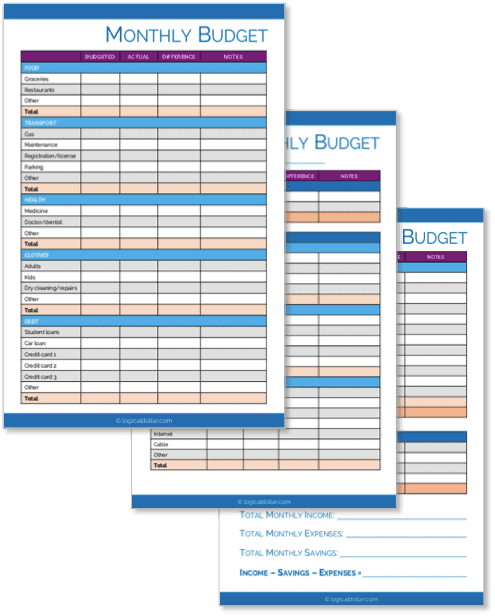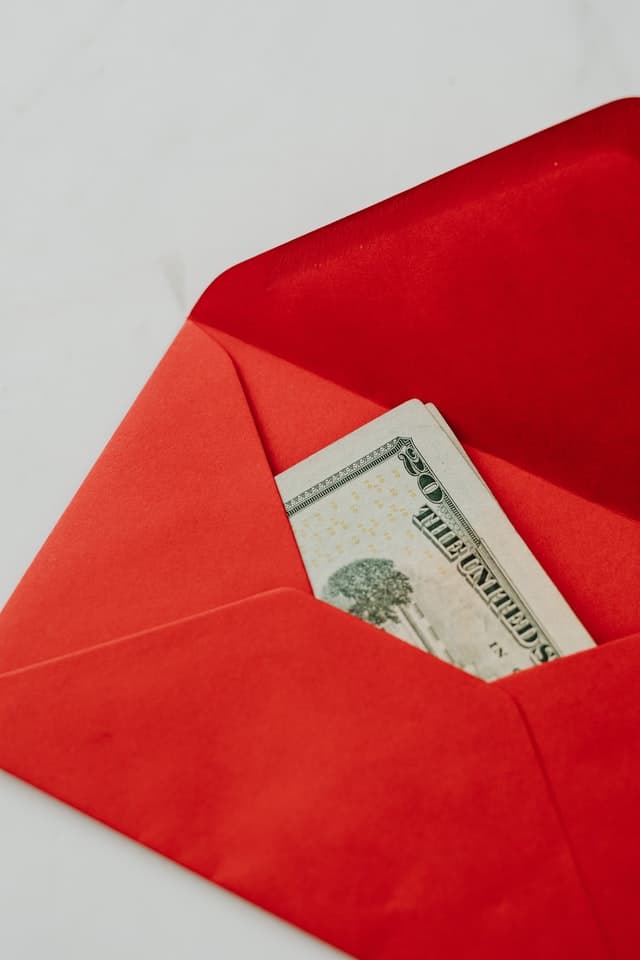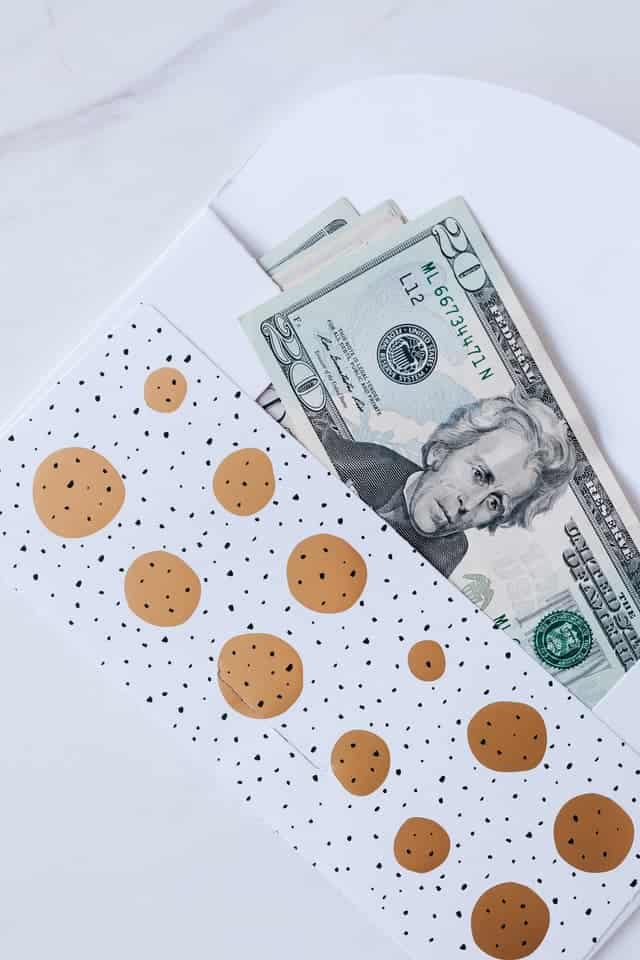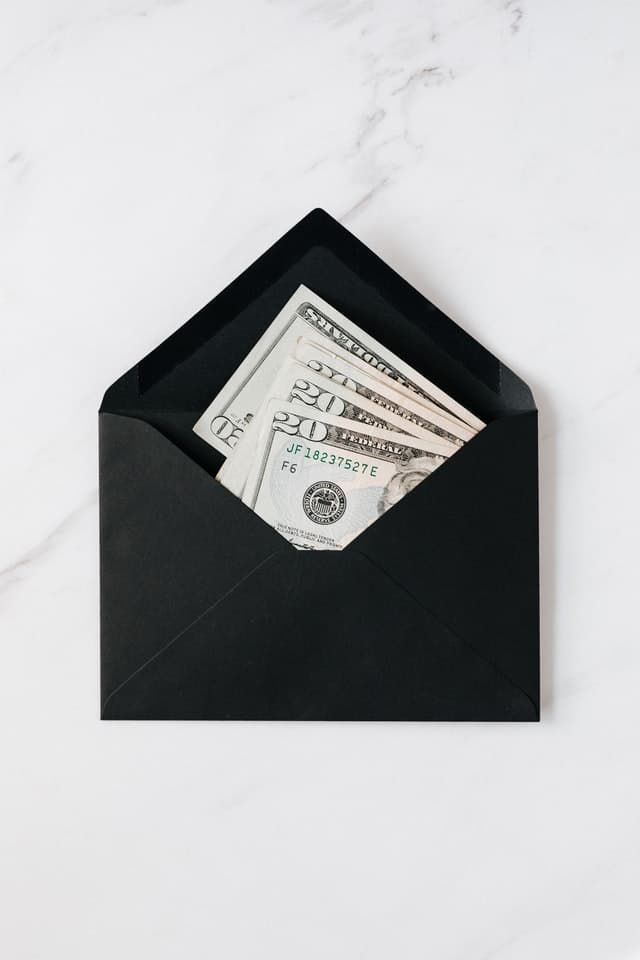Saving money can sometimes feel like an endless battle between putting aside money for the future and all those things you need (or want!) to buy now.
While the easiest way to save would be having a pile of money appear in your lap, it helps to have as many things motivating you to save as possible. And the 100 envelope challenge is one tool you can use to save better while having some fun!

TAKE BACK CONTROL OF YOUR FINANCES
Our free budget planner will help you to quickly and easily take control of your money – instead of it controlling you.
Get it free for a limited time!
You’ll also join our mailing list to get updates on how to manage your money – unsubscribe at any time at the end of each email.
What is the 100 envelope challenge?
The 100 envelope challenge is a simple saving method where you take 100 envelopes and write the numbers 1 to 100 on them. You then select an envelope at random every day and put an amount of cash in it equivalent to the number on the front of the envelope. After 100 days, you’ll have saved $5,050.
With a combination of gaming and social elements, it has proven to be super popular, particularly on various social media platforms. In fact, you may have first seen the 100 envelope challenge on TikTok where the hashtag #100envelopechallenge has really taken off.
@simplisticallyliving How To Do The 100 Envelope Challenge! ##LearnOnTikTok ##TikTokPartner ##100envelopechallenge ##100envelopes ##savingchallenge ##fyp
♬ SAVE ME – Ben Garlock
And if you’d like some history on this, here goes: The 100 envelope savings challenge actually invokes a popular tale in the math world about Carl Friedrich Gauss (1777-1855), a well known scholar. When presented with the task of adding up all the numbers between 1 and 100 as a child, he discovered a trick that let him break the process down and find the final answer of 5,050 much faster than his teachers expected.
Showing the teachers how he found the answer may have led to them putting him in more advanced classes where his talent could flourish. So when every envelope is full after you follow the challenge, this number can jump start your finances the same way it did Gauss’s life as a mathematician.
How to do the 100 envelope challenge
1. Get a stack of 100 envelopes
The envelopes are, as might be expected, a key part of the 100 envelope challenge. Standard letter-sized envelopes like these are a great size for cash (and look great too!).
If you don’t mind folding or crinkling your bills, smaller envelopes can work in a pinch. They also work just fine if you’re using coins for a toned down version of the challenge.

2. Number each with a dollar amount from 1 to 100
You should now number each of your envelopes from 1 to 100. It’s fine to just do these in order for now, as you’ll mix them up, kind of like a deck of cards, at the next step.
3. Put the empty envelopes in a box
The easiest option here is to simply place the empty envelopes in a box, but you can use some other container, like a basket, if that’s what you have on hand. Any sort of shoe box or similar will work.
That said, it’s good to have this in a conspicuous place so you’re motivated to do the challenge every day. For that reason, you may not just want a standard shoe box sitting on your counter, so feel free to decorate it for an added push of motivation. You could even get one that’s already decorated, like this beautiful storage box, if you feel like your creativity skills aren’t up to par (…just me?)

Before putting the envelopes in your box, make sure you shuffle them. Remember, the aim of the 100 envelope challenge is to pick a random amount to save every day. This is why having them in order won’t work, as you’ll always know roughly how much you’re committing to save that day.
4. Each day, pick one envelope at random
Every day, without looking, grab one of the envelopes from the box. Part of the appeal of the challenge is never knowing what you’ll be saving each day.
That said, if you cheat a bit to save less on a day where you’re strapped or save more on a day when you have extra, no one will snitch. It’s not entirely in the spirit of the 100 day challenge though, so try to keep those days to a minimum.
5. Put the labeled dollar amount in the envelope
Insert cash with a value equal to whatever the face of the envelope shows. So if you pull out the envelope with 32 written on it, put $32 in cash in the envelope
Try not to think about the show tickets or new game you want to get. Find some fun things to do with your friends that are free rather than going out for dinner this week. Pull out that recipe book for some frugal meal ideas instead of pulling up the delivery service app. Be strong.

MANAGE YOUR MONEY LIKE A BOSS
Managing your money effectively can literally change your life. And starting a budget using our budget planner is the first step towards you doing just that.
Get it free for a limited time!
You’ll also join our mailing list to get updates on how to manage your money – unsubscribe at any time at the end of each email.
6. Set the filled envelope aside
It’s best to put the filled envelopes in a secure spot. On the other hand, if you’re convinced that the box with your envelopes is safe, consider putting the filled envelopes at the back of the box – perhaps upside down or with a divider between them and the empty envelopes, so you know where to pick the empty envelopes from.
However, there’s going to quickly be several thousands of dollars in those envelopes, so be careful if you’re planning to save this money without a bank account.
As a far more secure option, you could consider putting the money you save into a savings account (my favorite high interest savings account is below), by transferring the amount on each envelope every day rather than using cash.
CIT Bank – Money Market Account
Our pick: Best high interest savings account
Why? Well, because it’s got:
- 1.00% interest (over 11 times higher than the national average)
- No fees and only a $100 minimum deposit
- FDIC insured, meaning your money’s safe
7. Track your progress
While you don’t strictly have to do this, if you want an added boost of motivation, you could consider using a 100 envelope challenge tracker. That involves either tracking that you’ve actually done the challenge that day or tracking how much you save each day, with the goal in the end of coloring in your tracker all the way to the $5,050 saved by the end.
An alternative to this for tracking your progress in the 100 envelope challenge is an app. Any habit tracker app will do the trick, with my personal favorite being HabitBull as it’s simple and, best of all, free!
8. Continue each day
You don’t complete the 100 envelope savings challenge just by filling one envelope, so keep at it until your empty envelope box is empty.
And before you know it, you’ll have saved just over $5,000!
How long does the 100 envelope challenge take?
At the normal challenge rate of one envelope per day, the 100 envelope challenge takes 100 days or just over three months. You can also adjust this, like only doing it on weekdays, in which case it would take around five months.
Of course, other adjustments can be made – if you forget a day or two along the way, it might take longer. But you’re fine to adjust the time scale up or down to suit your needs.

Just don’t adjust it too much so you’re not making this as much of a challenge as it could be. For example, you could fill up an envelope each week, in which case it would take a little under two years to complete. While saving any money is great, saving $5,050 over two years is equivalent to saving around $210 per month – and you may be able to push yourself to save more than that, no?
You could even scale this up to two envelopes a day, which would only take a month and a half. As an alternative, you can try to save $10k in 100 days with this envelope challenge.
That said, you’ll have to make more sacrifices to keep up with that level of savings, so consider whether that’s actually realistic for you.
Can I do the 100 envelope challenge in six months?
Altering the 100 envelope challenge to better suit you, such as extending the time out to six months, is perfectly acceptable. All you’d have to do is pick an envelope every other day instead of every day. In just over six months, you’ll have saved $5,050.
You could go further by changing the 100 envelope savings challenge to twice a week. It’ll take you just under a year to save the same amount, but it may be a more manageable target if things are tight. Do the challenge on days where you’re more likely to spend money, and it can help curb your urge to splurge.
Changing the amount can help, too. An extreme drop to adding the amount in cents rather than dollars will get you $50.50 in that same time, for example. Even if it’s not much, it can help you get into a saving habit.
Do the 100 envelope challenge math
You will save $5,050 if you follow the 100 envelope challenge, but a little math can prove it to you. There are two ways to figure out how much money you’ll save by the end of the challenge: adding all the envelope values together, or using the formula stemming from Gauss’s work to cut the process down to a few short steps.
The first way – adding up each number – is the simplest on the surface, but it will take more time in the end. For the standard $1 starting point, you would add $1 to $2 to get $3, $3 to $3 to get $6, and so forth. If you want to see how helpful the faster way is, go ahead and finish adding it together. Feel free to use a calculator!

Since each envelope increases by one, the finalized version of Gauss’s formula allows you to skip ahead to the final answer with this algebraic expression: (n/2)(n+1). Put another way, cut the highest number in half, then multiply that by the highest number plus one.
The n is the biggest number that you plan on counting, so n is equal to 100 if you want to add 1 through 100. For the 100 envelope challenge, you divide 100 by 2 to get 50, then multiply that by 101 to get 5,050.
Throw a dollar sign in front of that, and that’s how much you saved! Even if you use a calculator, the second way is much faster once you get the hang of it.
Other ways to use the 100 envelope savings challenge formula
(You can skip this part if you’re more interested in the saving aspect of this challenge, but the math helps to show just how far you can take this challenge – and it’s not too algebra-heavy, promise!)
Changing the variables in the 100 envelope savings challenge can make it more affordable and an activity that everybody in the household can enjoy. For example, lowering the starting amount to just a penny and increasing the number of envelopes to 365 makes it a great way to help a small kid practice saving, get a math lesson, and celebrate their birthday.

Make a birthday activity out of having them help you with decorating the basket, setting up the tracker, and labeling the envelopes. Each day, let them count out the money before it goes into the envelope. If they get curious about how much they’ll save, you can show them the handy formula you might’ve just learned.
In this case, the “n” in the formula would be 365. Divided by half, you get 182.5, which you would then multiply by 366 (also known as 365+1). That gets you 66,785! Since the challenge started with a penny, though, you have to divide the answer by 100 to get the dollar value of $667.85 saved over the year.
That’s about $12 a week, which isn’t a shabby allowance for a child. For older children, you can take turns having them put in savings from their allowance and helping contribute to the fund so they can feel more of the responsibility. You could shorten the time period down to a month for younger children with less of an attention span, unless you want over $600 of Paw Patrol and Octonauts toys littering your floor.
Can I use the 100 envelope challenge to save $10,000?
To save $10,000 with the 100 envelope challenge, you could simply do it twice to save just over that amount in 200 days. Alternatively, you can label the 100 envelopes with numbers from 50 to 150 and skip number 100. That way, you’ll save $10,000 in 100 days.
While using this to save $10,000 is great, you can even complete three full challenges over the course of a year to save $15,150, which is definitely a great savings rate.
Is the 100 envelope challenge worth it?
Pros
- It’s simple.
- It saves a decent amount of money.
- You’ll learn a bit of math and math history.
- Making it a challenge can motivate you.
- Repeatedly saving can turn it into a habit.
- It’s easy to modify the challenge to suit your needs.
- There’s no penalty for stopping if it’s not working for you.
Cons
- Random saving amounts are harder to factor into your plans if you’re living on a budget.
- The default amount and rate would put a strain on the average income.
- Keeping the money in one set of envelopes is a theft risk.
- Investing or depositing the money in a savings account could have greater returns.
Weighing these pros and cons, the basic format of the 100 envelope money saving challenge is at least worth considering. This is especially if you know you should be saving money and you’ve been meaning to set aside spare cash, but you frequently forget or cave to temptation before it lands in your savings. You might have to make some modifications that work for you, but doing that can help you have a better handle on your finances.
It works best if you regularly take the filled envelopes and deposit them into a high-yield savings account or another long-term, reliable investment. Storing it in a safe at home so you can bathe in a pile of bills at the end is definitely tempting, but safe investments keep your money physically safe and earn you a little extra.
(You also may want to consider creating a 100 envelope challenge chart to track your progress.)
And once you see those numbers go up, you’ll see how addictive saving can really get!

READY FOR MORE?
Join thousands of subscribers in getting regular tips in your inbox on how to take control of your finances and save more money – and, for a limited time, get our free budget planner as a gift!
You’ll also join our mailing list to get updates on how to manage your money – unsubscribe at any time at the end of each email.






